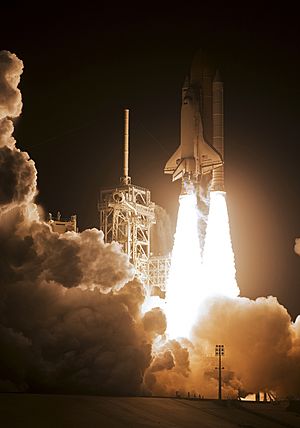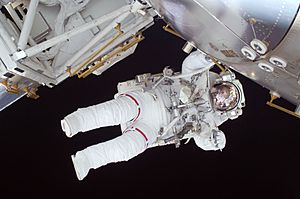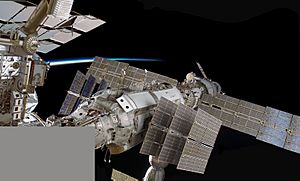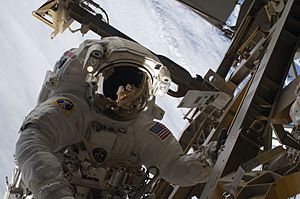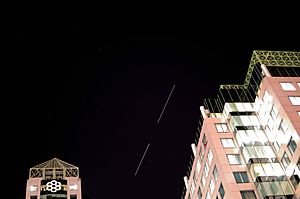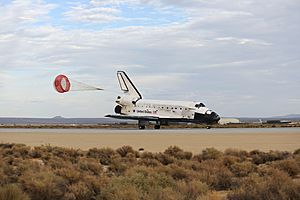STS-128 facts for kids
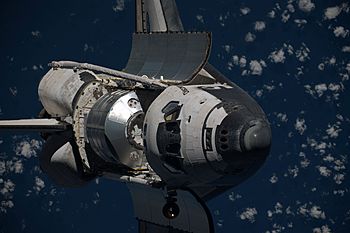
Discovery approaches the ISS with Leonardo in its payload bay
|
|
| Mission type | ISS assembly |
|---|---|
| Operator | NASA |
| Mission duration | 13 days, 20 hours, 54 minutes, 55 seconds |
| Distance travelled | 9,262,217 kilometres (5,755,275 mi) |
| Orbits completed | 219 |
| Spacecraft properties | |
| Spacecraft | Space Shuttle Discovery |
| Launch mass | 121,422 kilograms (267,689 lb) |
| Crew | |
| Crew size | 7 |
| Members |
|
| Launching | |
| Landing |
|
| Start of mission | |
| Launch date | 29 August 2009, 03:59 UTC |
| Launch site | Kennedy LC-39A |
| End of mission | |
| Landing date | 12 September 2009, 00:53 UTC |
| Landing site | Edwards Runway 22 |
| Orbital parameters | |
| Reference system | Geocentric |
| Regime | Low Earth |
| Perigee | 219 kilometres (136 mi) |
| Apogee | 264 kilometres (164 mi) |
| Inclination | 51.6 degrees |
| Period | 89.33 minutes |
| Epoch | 29 August 2009 |
| Docking with ISS | |
| Docking port | PMA-2 (Harmony forward) |
| Docking date | 31 August 2009, 00:54 UTC |
| Undocking date | 8 September 2009, 19:26 UTC |
| Time docked | 8 days, 18 hours, 32 minutes |
  Seated (l–r) Ford and Sturckow. Standing (l–r) are Hernández, Olivas, Stott, Fuglesang and Forrester. |
|
STS-128 was a NASA Space Shuttle mission to the International Space Station (ISS). It launched on August 28, 2009. The Space Shuttle Discovery (also known as Space Shuttle Discovery) carried a special cargo module called Leonardo. This module brought many new experiments and supplies to the space station.
During the mission, astronauts performed three spacewalks. They replaced a science experiment outside the European Columbus module. They also brought back an empty tank that held ammonia, which is used for cooling the station.
The mission's launch was delayed a few times. First, bad weather stopped the launch. Then, a small problem with a fuel valve on Discovery caused another delay. Finally, Discovery launched successfully on August 28, 2009. It landed on September 11, 2009, at Edwards Air Force Base in California. This was the last time a Space Shuttle landed at that base.
Contents
- Meet the Crew: Who Flew on STS-128?
- What Did Discovery Carry?
- Mission Highlights: What Happened Day by Day?
- August 28 (Flight Day 1 – Launch)
- August 29 (Flight Day 2 – Checking the Shuttle's Health)
- August 30 (Flight Day 3 – Docking with the ISS)
- August 31 (Flight Day 4 – Moving Leonardo)
- September 1 (Flight Day 5 – Spacewalk 1)
- September 2 (Flight Day 6)
- September 3 (Flight Day 7 – Spacewalk 2)
- September 4 (Flight Day 8)
- September 5 (Flight Day 9 – Spacewalk 3)
- September 6 (Flight Day 10 – Getting Ready to Go Home)
- September 7 (Flight Day 11 – Saying Goodbye)
- September 8 (Flight Day 12 – Undocking)
- September 9 (Flight Day 13 – Preparing for Landing)
- September 10 (Flight Day 14 – Landing Postponed)
- September 11 (Flight Day 15 – Landing)
- Spacewalks: Working Outside in Space
- Wake-up Calls: Music in Space
- Images for kids
- See also
Meet the Crew: Who Flew on STS-128?
| Position | Launching astronaut | Landing astronaut |
|---|---|---|
| Commander | Fourth (last NASA) spaceflight |
|
| Pilot | First spaceflight |
|
| Mission Specialist 1 | Third and last spaceflight |
|
| Mission Specialist 2 | Only spaceflight |
|
| Mission Specialist 3 | Second and last spaceflight |
|
| Mission Specialist 4 | Second and last spaceflight |
|
| Mission Specialist 5 | Expedition 20 First spaceflight |
Expedition 20 First spaceflight |
What Did Discovery Carry?
The STS-128 mission carried a lot of important cargo. Here's a look at some of the main items:
| Location | Cargo | Mass |
|---|---|---|
| Bays 1–2 | Orbiter Docking System EMU 3009 / EMU 3015 |
1,800 kilograms (4,000 lb) ~260 kilograms (570 lb) |
| Bay 3P | Shuttle Power Distribution Unit (SPDU) |
~17 kilograms (37 lb) |
| Bay 4P | APC/MISSE Carrier | 57 kilograms (126 lb) |
| Bay 5P | APC/MISSE Carrier | 57 kilograms (126 lb) |
| Bay 7S | ROEU umbilical | ~79 kilograms (174 lb) |
| Bays 7–12 | Leonardo (MPLM FM-1) | 12,131 kilograms (26,744 lb) |
| Bay 13 | Lightweight MPESS Carrier (LMC) | 1,780 kilograms (3,920 lb) |
| Starboard Sill | Orbiter Boom Sensor System | ~382 kilograms (842 lb) |
| Port Sill | Canadarm | 410 kilograms (900 lb) |
| Total: | 16,973 kilograms (37,419 lb) |
The Leonardo Module: A Space Delivery Truck
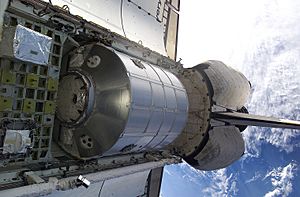
The main cargo for STS-128 was the Leonardo module. This module is like a moving truck for space. It helped bring many supplies and new equipment to the International Space Station. This was important to help the station get ready to host a larger crew of six astronauts.
Leonardo carried several key items:
- Three racks for life support systems.
- A new sleeping area for astronauts, installed in the Kibo module.
- A new treadmill called COLBERT. This treadmill helps astronauts exercise in space.
- An Air Revitalization System (ARS) to help clean the air on the station.
Lightweight Multi-Purpose Carrier (LMC)
The shuttle also carried a special carrier called the Lightweight Multi-Purpose Experiment Support Structure Carrier (LMC). It held a new Ammonia Tank Assembly (ATA). This new tank was needed to replace an old, empty one during a spacewalk.
TriDAR: A Smart Camera for Space
The STS-128 mission was the first test flight for a new device called TriDAR. This is a 3D laser camera that helps spacecraft find and connect with other objects in space on their own. During the mission, TriDAR successfully tracked the ISS as Discovery approached it for docking.
Other Science Experiments
Discovery also brought three science racks to the ISS:
- The FIR (Fluids Integrated Rack) and the first Materials Science Research Rack (MSRR-1) were placed in the Destiny module.
- The MELFI-2 (Minus Eighty Laboratory Freezer for ISS) was placed in the Kibo module.
The FIR helps scientists study how liquids behave in microgravity (very low gravity). This is important for understanding chemical reactions in space. For example, one experiment looked at how mixtures called colloids act without gravity stirring them.
Mission Highlights: What Happened Day by Day?
August 28 (Flight Day 1 – Launch)
Discovery launched at 11:59 PM EDT. After reaching orbit, the crew opened the shuttle's cargo bay doors. They then set up the Ku-band antenna and the Shuttle Remote Manipulator System (SRMS), which is the shuttle's robotic arm. The crew also sent pictures of the external fuel tank back to Earth. This helped engineers check how the tank performed during launch.
August 29 (Flight Day 2 – Checking the Shuttle's Health)
On their first full day in space, the crew used the SRMS to grab the Orbiter Boom Sensor System (OBSS). They used this system to check the shuttle's heat shield (Thermal Protection System or TPS) for any damage. Some crew members also prepared the spacesuits and tools for the upcoming spacewalks.
August 30 (Flight Day 3 – Docking with the ISS)
Discovery successfully docked with the International Space Station. Before docking, Commander Rick Sturckow performed a special flip maneuver. This allowed the ISS crew to take photos of the shuttle's belly. These photos were sent to Mission Control for review. After docking, astronaut Nicole Stott officially joined the ISS crew, and Timothy Kopra became part of the shuttle crew. The teams also began moving items from the shuttle to the station.
August 31 (Flight Day 4 – Moving Leonardo)
On flight day 4, the Leonardo module was moved from the shuttle's cargo bay and attached to the Harmony module on the ISS using the Space Station Remote Manipulator System (SSRMS), the station's robotic arm. Once attached, the crew opened Leonardo and began moving supplies inside. Astronauts Danny Olivas and Nicole Stott also prepared their spacesuits and tools for the first spacewalk.
September 1 (Flight Day 5 – Spacewalk 1)
The first spacewalk (EVA 1) took place. Astronauts removed an empty ammonia tank and also took off two science experiments (EuTef and MISSE 6) from outside the station. These experiments were stored in the shuttle for return to Earth. Inside the station, other crew members moved the new crew sleeping area, the COLBERT treadmill, and the Air Revitalization System.
September 2 (Flight Day 6)
The crew continued setting up the new sleeping area. They also moved the last major science items from Leonardo to the station. These included the Fluids Integrated Rack (FIR), the Materials Science Research Rack, and the Minus Eighty Laboratory Freezer ISS 2 (MELFI-2). Astronauts Danny Olivas and José M. Hernández answered questions from the public. Olivas and Christer Fuglesang prepared for the second spacewalk by spending the night in the airlock at a lower air pressure.
September 3 (Flight Day 7 – Spacewalk 2)
Astronauts Danny Olivas and Christer Fuglesang performed the second spacewalk (EVA 2). They installed the new Ammonia Tank Assembly (ATA). This new tank, weighing about 1,800 pounds (816 kg), was the heaviest item ever moved by spacewalking astronauts. They also installed protective covers on the cameras of the station's robotic arm. Inside, the rest of the crew continued moving items between the shuttle and the station.
September 4 (Flight Day 8)
The crew had some time off. They shared a meal, took a group photo, and talked to the public. More cargo was moved between the shuttle and the station. Astronauts Timothy Kopra and Nicole Stott continued their handover activities, as Stott was taking over Kopra's role on the station. Olivas and Fuglesang prepared their spacesuits for the third spacewalk.
September 5 (Flight Day 9 – Spacewalk 3)
Astronauts Danny Olivas and Christer Fuglesang completed the third and final spacewalk (EVA 3). They installed two GPS antennas and a new Rate Gyro Assembly. They also routed cables for the Node 3 module, which would arrive later. The crew also replaced a bolt on a docking mechanism to make sure future spacecraft could connect properly.
September 6 (Flight Day 10 – Getting Ready to Go Home)
The crews transferred science samples from the space station to a special freezer on the shuttle called Glacier. These samples would be returned to Earth for scientists to study. The crew also started closing up the Leonardo module, getting it ready to be moved back into the shuttle. The last part of the day was spent off duty.
September 7 (Flight Day 11 – Saying Goodbye)
The joint crews finished moving all the cargo. They then closed the hatches of the Leonardo module. After that, Leonardo was detached from the ISS and placed back into the shuttle's cargo bay. Astronauts José M. Hernández and Nicole Stott spoke to the public. The two crews then said their goodbyes and closed the hatches between the shuttle and the ISS. The shuttle crew then prepared their tools for undocking.
September 8 (Flight Day 12 – Undocking)
Space Shuttle Discovery successfully undocked from the International Space Station at 7:26 PM UTC. After undocking, the shuttle flew around the ISS, allowing the crew to take photos. The astronauts then used the Orbiter Boom Sensor System (OBSS) to inspect the shuttle's heat shield one last time.
September 9 (Flight Day 13 – Preparing for Landing)
On flight day 13, the shuttle crew began putting away items for landing. Commander Frederick W. Sturckow and pilot Kevin A. Ford checked the shuttle's flight control systems and communication with the ground. The crew also reviewed the landing procedures.
September 10 (Flight Day 14 – Landing Postponed)
Discovery was scheduled to land at Kennedy Space Center. However, bad weather conditions caused the landing to be delayed twice.
September 11 (Flight Day 15 – Landing)
After the delays, Discovery started its journey back to Earth. It landed safely at Edwards Air Force Base in California at 8:53 PM EDT. This landing was the last time a Space Shuttle mission ended at Edwards Air Force Base. Discovery was later flown back to Kennedy Space Center on September 21, 2009.
Spacewalks: Working Outside in Space
During the STS-128 mission, astronauts performed three spacewalks. Each spacewalk was planned to last about 6.5 hours.
| EVA | Spacewalkers | Start (UTC) | End (UTC) | Duration |
|---|---|---|---|---|
| EVA 1 | John D. Olivas Nicole Stott |
1 September 2009 21:49 UTC |
2 September 2009 04:24 UTC |
6 hours, 35 minutes |
| The astronauts got ready to replace an empty ammonia tank on the station. They also collected the Materials International Space Station Experiment and European Technology Exposure Facility from outside the Columbus lab. These experiments were put into Discovery's cargo bay to be brought back to Earth. :Robotic Arm Operators: Ford and Thirsk |
||||
| EVA 2 | John D. Olivas Christer Fuglesang |
3 September 2009 22:13 UTC |
4 September 2009 04:51UTC |
6 hours, 39 minutes |
| The spacewalkers moved the new ammonia tank from the shuttle's cargo bay and installed it on the station. They replaced it with the old, used tank. The new tank weighed about 1,800 pounds (816 kg), making it the heaviest item ever moved by spacewalking astronauts. With this spacewalk, ESA astronaut Christer Fuglesang became the first person not from an American or Russian space program to do four or more spacewalks. :Robotic Arm Operators: Ford and Stott |
||||
| EVA 3 | John D. Olivas Christer Fuglesang |
5 September 2009 20:39 UTC |
6 September 2009 03:40 UTC |
7 hours, 01 minutes |
| The astronauts prepared the station for the arrival of the Tranquility module. They attached cables between parts of the station. They also replaced a communication device, installed two new GPS antennas, and replaced a circuit breaker. | ||||
Wake-up Calls: Music in Space
NASA has a fun tradition of playing music to wake up astronauts in space. This started during the Gemini program. Each song is chosen specially, often by the astronauts' families. The songs usually have a special meaning to an astronaut or relate to their daily tasks.
| Flight Day | Song | Artist | Played for | Links |
|---|---|---|---|---|
| Day 2 | "Back In The Saddle Again" | Gene Autry | Frederick W. Sturckow | WAV MP3 TRANSCRIPT |
| Day 3 | "Made to Love" | TobyMac | Nicole Stott | WAV MP3 TRANSCRIPT |
| Day 4 | "Mi Tierra" | Gloria Estefan | José M. Hernández | WAV MP3 TRANSCRIPT |
| Day 5 | "Indiana, Our Indiana" | Indiana University Band | Kevin A. Ford | WAV MP3 TRANSCRIPT |
| Day 6 | "What a Wonderful World" | Louis Armstrong | Christer Fuglesang | WAV MP3 TRANSCRIPT |
| Day 7 | "There is a God" | 33Miles | Patrick G. Forrester | WAV MP3 TRANSCRIPT |
| Day 8 | "What a Wonderful World" | Louis Armstrong | Danny Olivas | WAV MP3 TRANSCRIPT |
| Day 9 | "El Hijo del Pueblo" | José Alfredo Jiménez | José M. Hernández | WAV MP3 TRANSCRIPT |
| Day 10 | "Rocket" | Andrew Peterson | Patrick G. Forrester | WAV MP3 TRANSCRIPT |
| Day 11 | "Only One" | Jeremy Kay | John D. Olivas | WAV MP3 TRANSCRIPT |
| Day 12 | "Beautiful Day" | U2 | Timothy Kopra | WAV MP3 TRANSCRIPT |
| Day 13 | "Sailing" | Rod Stewart | Christer Fuglesang | WAV MP3 TRANSCRIPT |
| Day 14 | "Good Day Sunshine" | The Beatles | Kevin A. Ford | WAV MP3 TRANSCRIPT |
| Day 15 | "Big Boy Toys" | Aaron Tippin | Frederick W. Sturckow | WAV MP3 TRANSCRIPT |
Images for kids
-
STS-128 as seen from Bartram Springs in Jacksonville, FL
-
Long exposure picture of STS-128 launching
See also
 In Spanish: STS-128 para niños
In Spanish: STS-128 para niños



